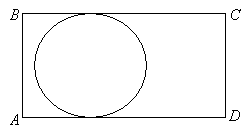

SAT Practice Test 1, Section 6: Questions 1 - 5
Related Topics:
More Lessons for SAT Preparation
Math Worksheets
This is for SAT in Jan 2016 or before.
The following are worked solutions for the questions in the math sections of the SAT Practice Tests found in the The Official SAT Study Guide Second Edition![]() .
.
It would be best that you go through the SAT practice test questions in the Study Guide first and then look at the worked solutions for the questions that you might need assistance in. Due to copyright issues, we are not able to reproduce the questions, but we hope that the worked solutions will be helpful.
1. Correct answer: (E)
Given:
![]()
To find:
The value for x
Solution:
![]()
Do not try to isolate or solve for x.
Just look at the equation carefully and you will see that x is replaced by 5.
So, x = 5.
Answer: (E) 5
2. Correct answer: (A)
Given:
x = 3
To find:
The value for y
Solution:
Topic(s): Pythagorean theorem
Be careful! 3-4-5 triangle is a special triangle, but not 2-3-4.
You will have to use Pythagorean theorem for this question.

Answer: (A)
3. Correct answer: (D)
Given:
All numbers that are divisible by both 2 and 6 are also divisible by 4.
To find:
The number to show that the statement is FALSE
Solution:
When you are given a statement to disproof, it is usually better to start from the conclusion, which is that the number is not divisible by 4.
All the given answers are divisible by 4 except for 18.
Now, is 18 divisible by 2? Yes. Is 18 divisible by 6? Yes.
So, 18 is a number that is divisible by both 2 and 6 but not divisible by 4.
Answer: (D) 18
4. Correct answer: (A)
Given:

The circle is tangent to the sides BC and AD
ABCD is an 8-by-12 rectangle
To find:
Area of the circle
Solution:
Topic(s): Area of circle
BC is the length and CD is the width of the rectangle.
Diameter of the circle = CD = 8
Radius of the circle = ![]()

Answer: (A)
5. Correct answer: (A)
Given:
a is the number of the sector where the arrow stops after the first spin
b is the number of the sector where the arrow stops after the second spin
To find:
The probability that the fraction ![]() is greater than 1
is greater than 1
Solution:
Topic(s): Fractions, probability
The fraction ![]() is obtained from the spin.
is obtained from the spin.
a is the number obtained from the first spin and b is the number obtained from the second spin.
For example, if you get a 3 from the first spin and a 5 from the second spin then the fraction obtained is ![]() .
.
There are 6 possible numbers in each spin.
Here are 6 possible numbers in each spin.
here are 6 possible numbers in each spin.

There are altogether 36 fractions with 15 fractions greater than 1.
So, the probability that the fraction ![]() is greater than 1 would be
is greater than 1 would be ![]()
(If you are able to see the pattern without writing out all the fractions then you will be able to do this faster).
Answer: (A)
Try the free Mathway calculator and
problem solver below to practice various math topics. Try the given examples, or type in your own
problem and check your answer with the step-by-step explanations.



We welcome your feedback, comments and questions about this site or page. Please submit your feedback or enquiries via our Feedback page.


